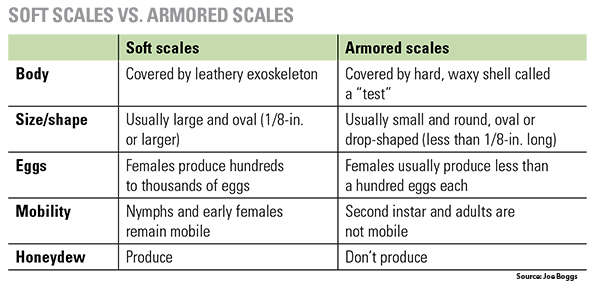
Photo: Brian Kunkel, University of Delaware, Bugwood.org
How to determine the most effective methods for treating scale insects.
Green Industry professionals facing down scale insects have a variety of treatment options on their hands, but knowing which one to choose for which species can be tricky. In May Joe Boggs, assistant professor at The Ohio State University Extension, and Rex Bastian, regional technical advisor for The Care of Trees in Wheeling, Ill., presented a webinar in conjunction with Landscape Management and sponsored by Valent Professional Products, on scale insect identification and treatment.
On the lookout
The first line of defense against scale is knowing the common species and hosts for the geographic area, Bastian says. Plant health care professionals should be on the lookout, particularly, for species that can cause significant injury, like euonymus scale or magnolia scale.
Whether the plant is plagued by soft or armored (hard) scale will have an impact on the plant’s symptoms (see “Soft scales vs. armored scales,” below).
For example, soft scales insert their mouthparts into the plant’s phloem bundle, damaging cells and causing localized symptoms. The main problem is soft scales withdraw large quantities of liquids, which they eventually void as sticky honeydew. The honeydew is problematic because it can allow fungi like black sooty mold to develop. Left unchecked, soft scales may result in dieback or death.
Armored scales also insert their mouthparts into plant cells. In this case the cells become damaged and die, producing leaf symptoms. Without treatment, heavy infestations may stunt plants and kill all or part of the plants.
The next step is to formulate a management plan. Biorational options include soaps/oils or insect growth regulators. Chemical approaches may include foliar sprays, soil applications, lower trunk sprays or trunk injections with systemic or contact insecticides.
Consider the following:
- Length of residual effect;
- If systemic, translocation speed;
- Possible side effects;
- Off-site movement;
- Mite outbreaks;
- Non-target effects; and
- Costs (product and labor).
Particular pests
One armored scale Boggs honed in on was euonymus scale.
When it comes to euonymus scale, the top three challenges are rapidly building populations, difficult detection due to some scale that may remain hidden on stems and the fact that two generations are produced per season.
Dormant oils don’t offer any control for euonymus scale, he says. With contact insecticides, it’s best to target crawlers, and timing is critical. Pyrethroids offer good control but require multiple applications. Effective systemic insecticides include dinotefuran and aceamidprid. The lady beetle is a beneficial insect to help combat euonymus scale.
On the soft scale side, Boggs addressed calico scale. He says professionals can target overwintering crawlers with a pyrethroid contact insecticide, though results haven’t been consistent. Likewise, you can target newly hatched crawlers with a contact pyrethroid product, but timing is important, he says. Effective systemic soil drench applications include imidacloprid or dinotefuran in late spring. From September to early November, imidacloprid, clothianidin or dinotefuran may work. Beneficial insects like the lady beetle are another option for lighter infestations.
Trend watch
Bastian noted a few trends in scale treatment, including the increased use of biorational materials for foliar applications. Insect growth regulators—especially for armored scale management—are another option on the rise. Finally, Bastian is seeing the use of soil-/bark-applied systemic chemicals more, especially for soft scales on large trees.

